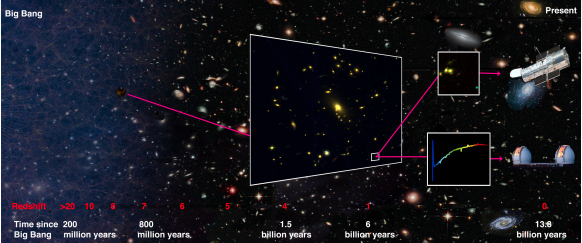Primordial galaxy discovered is first of its kind

Years of meticulous observing have resulted in a cosmic discovery that comes from an era dating back 13.1 billion years, giving scientists a detailed glimpse of what may have happened just a few hundred million years after the Big Bang.
Using the world-class Hubble Space Telescope and W. M. Keck Observatory on Maunakea, Hawaii, an international team of astronomers from the University of Melbourne, United States, and Europe has confirmed the existence of one of the most distant galaxies in the universe.
To characterise the faint galaxy, initially identified from Hubble Space Telescope observations, the discovery team used the MOSFIRE spectrograph, the most in-demand instrument on the 10-meter Keck I telescope.
What makes this galaxy extraordinary is that it is ordinary. It is thought to be a common galaxy at that distance and age of the universe.
However, such galaxies would normally be too faint to detect. The astronomers used a method called gravitational lensing to magnify the galaxy so they could study it.
University of Melbourne Senior Lecturer and Australian Research Council Future Fellow in the School of Physics, and co-author of the discovery Michele Trenti said: "There have been a few other discoveries of galaxies whose light has traveled for more than 13 billion years before reaching us, but they were all extremely luminous objects, brighter than our own Galaxy.
"In contrast, we estimate that this galaxy contains just 300 million stars."
The results were published today in Nature Astronomy, with Austin Hoag, a graduate student at the University of California Davis, as the lead author on the paper.
Named MACS1423-z7p64, the galaxy is at a redshift of 7.6, meaning its light came from when the universe was approximately 700 million years old.
Keck Observatory instrument program manager Marc Kassis said: “This is an awesome discovery in that it is the faintest galaxy at that redshift. It is very challenging to find an object at the very edges of the universe.
"In order to detect this galaxy, its light had to be lensed twice – once by a massive galaxy cluster, and a second time by the Keck Observatory telescope.”
Mr Kassis helped support Mr Hoag and his team, along with fellow support astronomers Luca Rizzi and Carlos Alvarez.
Faint galaxies are thought to be much more common than bright ones in the young Universe, but until today such population eluded confirmation of its existence.
“We think this galaxy is much more representative of other galaxies of its time,” said Mr Hoag.
To find such faint, distant objects, the discovery team took advantage of a method called gravitational lensing.
As light of the distant object passes by a massive object such as a galaxy cluster in the foreground, it gets bent by gravity, just as light gets bent passing through a lens. When the foreground object is massive enough, it will magnify the object behind it.
MACS1423-z7p64 just happened to fall into the “sweet spot” behind a giant galaxy cluster that magnified its brightness tenfold and made it first visible to the team using the Hubble Space Telescope.
They were then able to confirm its distance by analysing its spectrum using Keck Observatory’s MOSFIRE, which shows an emission line that is interpreted as Hydrogen Lyman-α, with its rest-frame wavelength redshifted 7.6 times.
Even though MACS1423-z7p64 is strongly magnified, the discovery has been extremely challenging and it required combining the initial data taken by University of California Davis researchers in 2015 with those from a second night of observations from Australian colleagues at the University of Melbourne in 2016.
“This detection of Lyman-α emission from the galaxy thus highlights the strength of collaborative research projects,” said Dr Trenti, principal investigator of the Australian observations.
“This discovery puts the University of California Davis, the University of California, Los Angeles, and the University of Melbourne on the map as one of the top astronomy centres in their nations,” said Dr Marusa Bradac, co-author of the study and principal investigator of the University of California Davis observations.
“For this kind of research, every meter counts, and with the low humidity on Maunakea, we would not have been able to discover this elsewhere.”